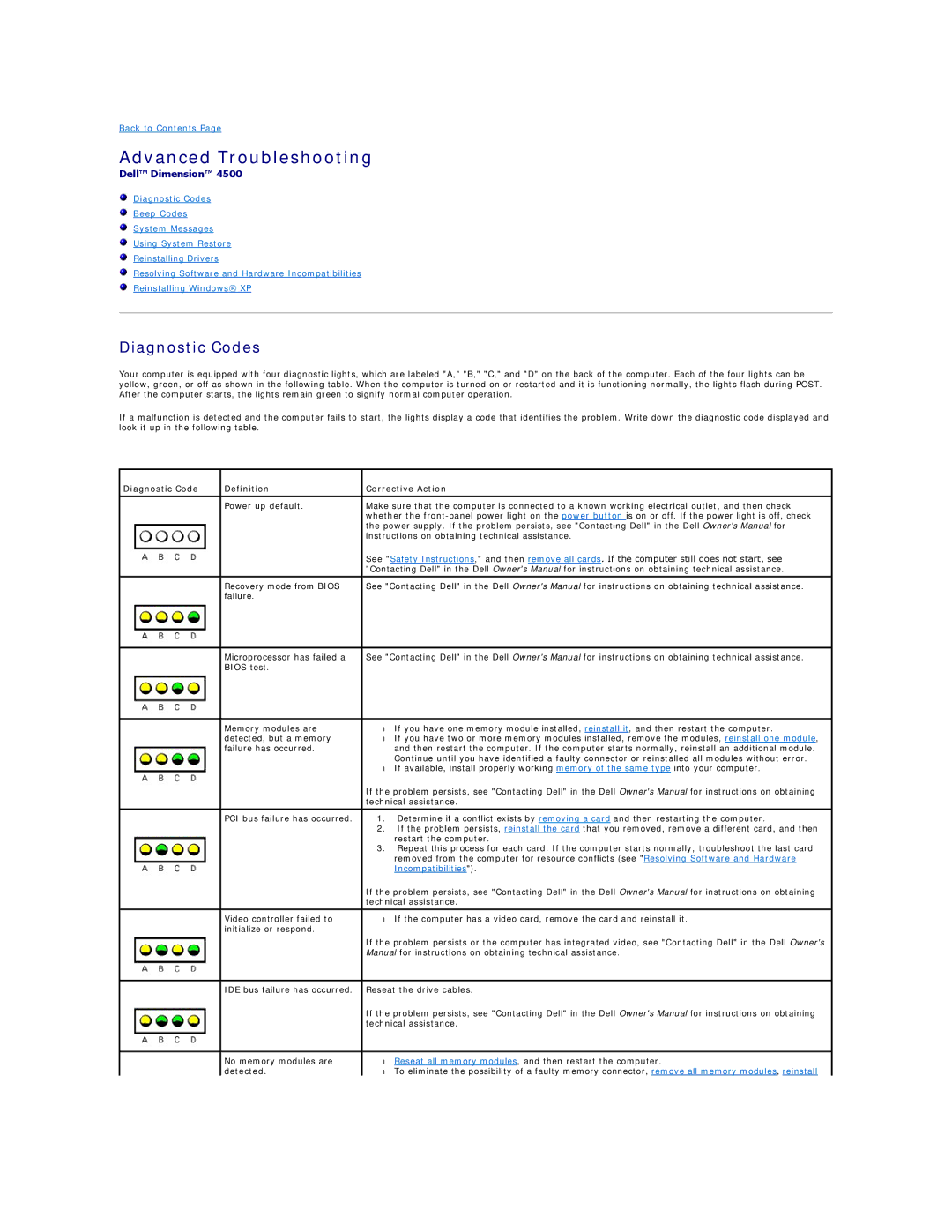
Back to Contents Page
Advanced Troubleshooting
Dell™ Dimension™ 4500
Diagnostic Codes
Beep Codes
System Messages
Using System Restore
Reinstalling Drivers
Resolving Software and Hardware Incompatibilities
Reinstalling Windows® XP
Diagnostic Codes
Your computer is equipped with four diagnostic lights, which are labeled "A," "B," "C," and "D" on the back of the computer. Each of the four lights can be yellow, green, or off as shown in the following table. When the computer is turned on or restarted and it is functioning normally, the lights flash during POST. After the computer starts, the lights remain green to signify normal computer operation.
If a malfunction is detected and the computer fails to start, the lights display a code that identifies the problem. Write down the diagnostic code displayed and look it up in the following table.
Diagnostic Code | Definition | Corrective Action | |
|
|
| |
| Power up default. | Make sure that the computer is connected to a known working electrical outlet, and then check | |
|
| whether the | |
|
| the power supply. If the problem persists, see "Contacting Dell" in the Dell Owner's Manual for | |
|
| instructions on obtaining technical assistance. | |
|
| See "Safety Instructions," and then remove all cards. If the computer still does not start, see | |
|
| "Contacting Dell" in the Dell Owner's Manual for instructions on obtaining technical assistance. | |
|
|
| |
| Recovery mode from BIOS | See "Contacting Dell" in the Dell Owner's Manual for instructions on obtaining technical assistance. | |
| failure. |
|
|
|
|
| |
| Microprocessor has failed a | See "Contacting Dell" in the Dell Owner's Manual for instructions on obtaining technical assistance. | |
| BIOS test. |
|
|
|
|
|
|
| Memory modules are | • | If you have one memory module installed, reinstall it, and then restart the computer. |
| detected, but a memory | • | If you have two or more memory modules installed, remove the modules, reinstall one module, |
| failure has occurred. |
| and then restart the computer. If the computer starts normally, reinstall an additional module. |
|
|
| Continue until you have identified a faulty connector or reinstalled all modules without error. |
|
| • | If available, install properly working memory of the same type into your computer. |
|
| If the problem persists, see "Contacting Dell" in the Dell Owner's Manual for instructions on obtaining | |
|
| technical assistance. | |
|
|
| |
| PCI bus failure has occurred. | 1. Determine if a conflict exists by removing a card and then restarting the computer. | |
|
| 2. If the problem persists, reinstall the card that you removed, remove a different card, and then | |
|
|
| restart the computer. |
|
| 3. Repeat this process for each card. If the computer starts normally, troubleshoot the last card | |
|
|
| removed from the computer for resource conflicts (see "Resolving Software and Hardware |
|
|
| Incompatibilities"). |
|
| If the problem persists, see "Contacting Dell" in the Dell Owner's Manual for instructions on obtaining | |
|
| technical assistance. | |
|
|
|
|
| Video controller failed to | • | If the computer has a video card, remove the card and reinstall it. |
| initialize or respond. |
|
|
|
| If the problem persists or the computer has integrated video, see "Contacting Dell" in the Dell Owner's | |
|
| Manual for instructions on obtaining technical assistance. | |
|
|
| |
| IDE bus failure has occurred. | Reseat the drive cables. | |
|
| If the problem persists, see "Contacting Dell" in the Dell Owner's Manual for instructions on obtaining | |
|
| technical assistance. | |
|
|
|
|
| No memory modules are | • | Reseat all memory modules, and then restart the computer. |
| detected. | • | To eliminate the possibility of a faulty memory connector, remove all memory modules, reinstall |
